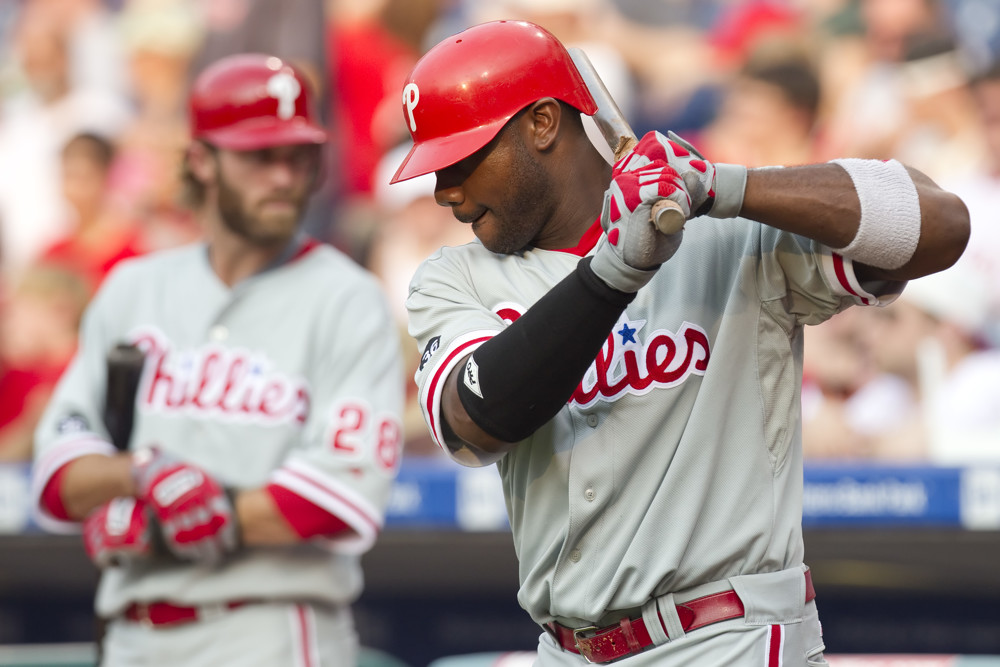

This story was originally published in July of 2020.
Over the past few days, it seems as though the sport is being turned around on its head. The universal DH is at least temporarily arriving in the National League in 2020 and extra innings will begin with a runner on second base. It reminds us of a time in recent Phillies history when almost every variable we believed to be constant in baseball wasn’t.
In May of 2010, Commissioner Bud Selig announced that the Blue Jays-Phillies series set for June 25-27 had been moved to Philadelphia due to security concerns surrounding the G20 Summit. The Phillies were still the designated away team, which meant the games were played under American League rules.
For the first time ever, public address announcer Dan Baker announced a lineup in Philadelphia that featured a designated hitter. Ryan Howard served as the DH in the first two games of the series while Raúl Ibañez had the honor in the series finale. Both teams had walk-up music.
The Phillies also batted first, which was bad news for fans who habitually arrived a few minutes late to the ballpark. They also wore road grays and if you were a fan back then who just casually tuned into the game, you were probably very confused to see Jimmy Rollins lead-off the game at Citizens Bank Park wearing the color gray.
For those who care about how the series factored into home-road splits, the Phillies stats counted as home splits and the Jays stats were factored in as if they were on the road. However, the three-game set was considered part of a homestand for the Jays.
The possibility of the “away team” winning the game in the last at-bat was also very real, but thankfully for the Phillies, that never happened. For some reason, however, the Phanatic did not have a road grey uniform in his closet.
Perhaps one Phillie was a bit disappointed that the series was moved to Philadelphia from Toronto: Roy Halladay. The series would have marked his return to Rogers Centre for the first time since being traded from the Blue Jays to the Phillies back in December of ’09. Halladay would eventually get the chance to pitch again in Toronto just over a year later.
Halladay received the nod in the first game of the series and he did exactly what anyone would expect him to do: throw seven shutout innings. The Phillies offense exploded in the fifth. The team sent 10 men to the plate and scored six runs to give the eventual NL Cy Young Award-winner an 8-0 lead.
The entire Halladay family was in attendance to watch Roy defeat his former club for the first time. His wife Brandy joined the Blue Jays’ broadcast and had this to say about the Halladay family’s new city:
I live with a GPS at all times. Adjusting well? It’s difficult to be in a new city. It’s a big city. It’s an aggressive city, but it’s amazing. It’s welcoming. It’s exciting. We have all new stadiums that we get to go to. New kids. New friends. The energy here is great. It’s been good.
The Phillies dropped the second game of the series to the Jays 5-1. The team going down in their final at-bat in the top of the ninth at Citizens Bank Park was a peculiarity unique to this series.
In the finale, 47-year-old Jamie Moyer opposed 24-year-old Brett Cecil, who was still in the womb when Moyer made his MLB debut on June 16, 1986. At the time, Moyer was tied with Phillies legend Robin Roberts for the all-time lead in home runs surrendered at 505. That record was broken in the bottom of the third when future 2010 All-Star Vernon Wells hit a two-run shot to left.
On a more positive note, Moyer became the 40th pitcher in MLB history to pitch at least 4,000 innings. Even better, Moyer and the Phillies would go on to crush the Jays 11-2.
Howard and Ibañez would combine to go 3-for-12 with one home run while serving as the DH. Small ball was the name for the game for the Phils as the team combined for 21 runs scored while hitting only two home runs. An array of fielding miscues courtesy of the Jays defense didn’t hurt as well.